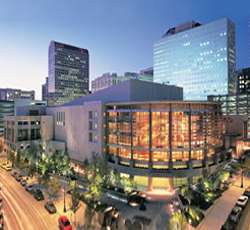
The V-Series selection was entirely empirical. “We first thought about using the d&b T-Series,” says Turpin. “We’d used this system in other locations and had good results. The hall specifically wanted a small footprint and T-Series certainly fit that bill.
“We also needed a well-behaved system, one that did what it said it would in the published performance data,” he adds. “You’re not going to get past 95 dB flat in this room without the low end going ballistic, so we thought the T-Series might get the job done, but we recognized that there might not be quite enough horsepower; that’s why we gave consideration to the larger V-Series.
“A determining factor was that the V-Series is still relatively small,” he adds, “meaning that the left and right arrays determined by vertical coverage were long enough to give defined pattern control down to lower frequencies; that was important in a lively hall such as this. Getting a good room solution with the main arrays is often very straightforward, if you can just get them in the right location.”
At The Margins
For the most part, that proved to be the case on this project. The design team actually spent more time tweaking the response at the margins of coverage where the fills take over, particularly the front fills and over balcony fills.
“In particular we needed to carefully spot where the mains drop out in the front rows, because the architecture pushes the main arrays very high off the deck and we have to lean on the front fills to get a good delay solution,” Turpin adds.
d&b E8 compact loudspeakers (2-way, integrated coaxial driver) serve as front fills while T10s handle the balcony. For low end enhancement, there are six V-SUB cardioid subwoofers (single 18-in, single 12-in) on the deck. All loudspeakers are driven by d&b D12 amplifiers and controlled via R1 Remote control software, which interfaces with the amps via 2 x R70 Ethernet to CAN interface. Modeling was done with d&b ArrayCalc and AFMG EASE.
“At the time ArrayCalc hadn’t yet developed the ability to accurately model the over balcony loudspeakers and the mains at the same time,” Turpin notes. “That said, now the system is in it does exactly what the calculations said it would; you can’t ask for more than that.”
One other criterion that made this solution attractive to the hall, as Anderson explains. “Carlson was a good choice for us because of their close proximity to the venue. Mark was familiar with all of the vendors, several were from out of state and all were considered, but a determinant was the limited time to make the installation. Benaroya Hall has a very busy schedule, so being geographically close meant such vendors had the ability to pop round for a few hours when time permitted, to do things like route cables, or fit amplifiers, prior to main installation.”
One dedicated week was set aside for installation of the main array hangs, but everything else was pretty much piecemeal as time allowed. In fact, the dedicated week saw three days to install the loudspeakers as well as complete final wiring, giving the team ample time to tune and familiarize themselves with the new system.
Turpin is not one for hyperbole, but he’s pleased with the outcome: “The response to the new system has been as good as it gets.”
Anderson is more illustrative of just how positive the reaction has been. “The first symphony event was a sort of Cotton Club era presentation, with many local talents performing in front of the Seattle Symphony. I mixed it and had a blast. The letters we got afterwards were amazing, just so many positive comments. The Seattle Symphony’s executive director, Simon Woods, came to me after the first show and said, ‘This has transformed the hall.’ Now that really is as good as it gets.”

